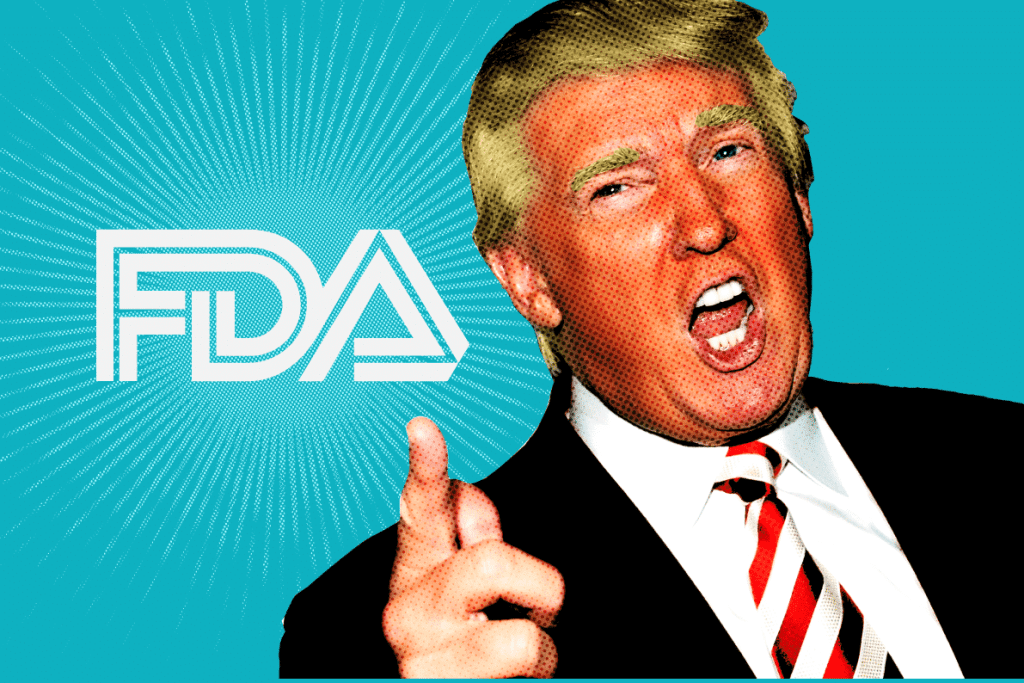
Trump’s FDA: Is the US regulator being steered by the President?
pharmafile | September 9, 2019 | Feature | Business Services, Manufacturing and Production, Medical Communications, Research and Development, Sales and Marketing | FDA, Trump, US, drug safety, pharma
FDA activity has fallen under Donald Trump, with the number of warning letters issued by the regulator dropping by a third since the President took office, according to a recent article published in Science. Louis Goss asks whether the current administration is affecting the direction of the organisation, or is it mostly independent of federal oversight?
In total, the FDA has sent out 1,033 warning letters under President Donald Trump, compared to 1,532 under former President Barack Obama over an equivalent period of time. The number of letters concerning tobacco products has fallen by 33%, warnings to food companies have dropped by 37%, and the number of letters to medical device companies has fallen by a massive 71%.
Meanwhile, the number of warning letters being sent to pharmaceutical companies has actually increased. Overall, the number of FDA warnings sent to pharma firms has risen by 62%, reaching a total of 188 since January 2017. For comparison, the FDA sent out 116 warnings under Obama over a similar period of time.
For many, the figures suggest that the FDA has, since Trump entered the White House, taken a laissez-faire approach towards food, tobacco and medical device companies, as they focus their efforts on pharmaceutical firms instead.
Critics have thus put the figures forward as evidence of the Trump administration’s influence over the FDA – the drop in the overall number of warning letters taken to be a result of a deregulatory ethos in the US Government. Many fear that sending fewer warning letters may in turn send out the wrong message to industry, as companies begin to feel they are free to do as they please.
The political pendulum
In response to the article in Science, former FDA commissioner Scott Gottlieb wrote: “We were pretty aggressive. I don’t think you can paint us with a political narrative – that just because we were a Republican administration, somehow we must have ratcheted down enforcement activity. We didn’t.”
The FDA added: “Sometimes the actions we take are visible, like warning letters (or) recalls… At other times, our actions to protect consumers are less discernible, but equally vital.”
Philip Katz, a partner at Hogan Lovells in Washington DC, offered an explanation: “The regulation that the FDA does – it sort of swings like a pendulum. FDA will be doing what it’s doing and critics will say ‘FDA, you’re in bed with the drug industry, and you’re too liberal and too lenient with the drug industry and you need to crack down – whether it’s in terms of enforcement or in terms of standards of approving drugs. You need to be tougher on the industry.’ So over time you’ll see the FDA move towards a slightly tougher stance. Then you’ll hear critics saying ‘you’re being unnecessarily harsh on the industry and holding it to impossible standards and you’re keeping all kinds of potentially useful treatments off the markets and that’s not good.’ So the FDA starts to swing back in the other direction.
“That back and forth ‘pendulum swing’ happens all the time, regardless of administration. What a change in administration does, is it affects how high the pendulum swings in one direction or the other and perhaps how quickly it shifts from one to the other. But it’s always in order of magnitude. It’s not in the overall nature.”
Yet Katz was clear in stating “Donald Trump’s administration is unlike any other,” as he pointed to the “fundamental shift” in the perspective of the Environmental Protection Agency (EPA): under Trump, the EPA removed all references to climate change from its website. Still, Katz felt that Trump’s eccentricities had not been reflected in the outlook of the FDA. “I haven’t seen any fundamental shifts in FDA since the Trump administration came in, and that’s consistent with my view over the past two or three decades… I had expected that things might have been different with the Trump administration because so much of what is the normal way that things have been done is not what Trump is doing.”
In making his point, Katz noted Trump’s choice of Scott Gottlieb as commissioner of the FDA: “In the very beginning of the Trump administration there was a lot of noise about who he might appoint as commissioner of the FDA and there were some folks who were thought to be very extreme in their views of the pharmaceutical industry – and I don’t mean pro-industry or anti-industry, just having very different views. That’s not who Trump nominated.
“Scott Gottlieb had been at the FDA before. He’d been working in that field. You can have a view as to whether Scott Gottlieb has been good or bad, or whether Scott Gottlieb has been pro-industry or not, but I don’t think you can say Scott Gottlieb is somebody from beyond the pale who came in from leftfield and fundamentally changed things. What Scott Gottlieb did was what most commissioners do – only I think he did it more efficiently and more effectively than most – and that is to take various proposals that have been in the works and that have been kicked around and under consideration, and prioritise them.”
Katz added that the composition of the FDA means that the agency is less likely than others to be influenced by politics: “I’ve been told that at FDA the ratio of political appointees to career is much lower than in other agencies. So while there are significant numbers of political appointees, the career people at FDA – people who are very high up in the FDA administration – have significant responsibility. Take Janet Woodcock for example, the current director of the Center for Drug Evaluation and Research (CDER). She’s been there forever. She’s highly respected, highly efficient and highly influential.
“So, I would think that if we’re seeing more warning letters being sent to pharmaceutical companies it may very well just be the ebb and flow of warning letters. It may just be what it is that drug companies are or are not doing, or how the law has evolved. For example, warning letters as regards to advertising and promotion have generally dropped over the years, and I think that’s more a function of other external factors. There were a spate of federal court decisions that highlighted the restrictions that our First Amendment puts on how FDA regulates what drug companies say, because commercial speech is speech, and the FDA guarantees freedom of speech. So there are restrictions on the government’s ability to control or restrict speech… Those kind of decisions influenced FDA and FDA warning letters as a matter of law, not as a matter of a shift in policy.
“In that regard, it wouldn’t surprise me that Trump hasn’t worked a fundamental change at FDA like he appears to have done in other agencies. Consistent with that theme, it would not be surprising to see an uptick in warning letters. I don’t know how meaningful the total number of warning letters issued in a given year or in a given period of time is, as opposed to the previous year or previous two years. I don’t know how meaningful that is but I wouldn’t think of it as indicating something from the Trump administration.”
Essentially, for Katz, the FDA is “very much a creature of science and the law.” In sticking to these, the FDA is prevented from becoming too overtly political. From the perspective of Katz, the FDA has stuck to these values so far, largely due to the actions of dutiful officials. Still, Trump, who is unusual in many ways, has for the most part been moderate in his interactions with the FDA, as is apparent in his choice of Scott Gottlieb as commissioner of the agency. Thus, for Katz, it is not governmental actors but rather long-term trends that have the major role in determining the current direction of the FDA.
Pricing – a case study
According to Ben Isgur, Health Research Institute Leader at PricewaterhouseCoopers, pricing is one such example of a long-term trend which determines the actions of the FDA. For both Isgur and Katz, the bipartisan issue of pricing is influencing decision making processes in the FDA, mainly in fuelling a drive towards increasing access to generic drugs.
Isgur explained: “The discussion that’s happening in the US right now – a lot of it is around pharmaceutical drug prices. What’s interesting is the issue of pricing spans politics. It’s actually a bipartisan issue.
“The reason that the issue of drug pricing is top of mind for a lot of US consumers and policymakers is because many consumers find healthcare simply unaffordable in the US, including some consumers who have insurance, because our insurance plans have moved towards what are called high-deductibles, which means that the consumer is actually paying sometimes as much as $2,000-$8,000 out-of-pocket, before insurance kicks in. So they feel the price of drugs more than a consumer 10 years ago or certainly 20 years ago, because of these types of health plans. That’s really why this has become a very big issue in the US.”
Politicians across the political spectrum have picked up on these concerns, with pricing issues having become a major policy focus for, among others, Donald Trump. Notably, in May 2018, the Trump administration published their plan to lower the price of prescription drugs in the US, under the title American Patients First. The blueprint is prefaced with a quote from the president himself, which reads: “One of my greatest priorities is to reduce the price of prescription drugs. In many other countries, these drugs cost far less than what we pay in the United States. That is why I have directed my Administration to make fixing the injustice of high drug prices one of our top priorities. Prices will come down.” Pricing has also been a long-term focus of left wingers, such as Vermont Senator and Democratic Presidential candidate Bernie Sanders.
However, when asked whether the FDA is similarly concerned about pricing, Katz said: “Do I think FDA is cognisant of cost issues? Yes I do. But what’s difficult about it, is it’s not easy to see how or where cost considerations, in a very direct way, fall within FDA’s bailiwick.”
Still, he continued in suggesting that the push for more generics is in fact being driven by concerns over costs. “Certainly, Scott Gottlieb focused on getting more generic drugs and biosimilars drugs to market,” Katz said. “That’s a cost-driven issue. The reason folks will say we need generic drugs is because they’re less expensive… The thought is that biosimilars will bring greater competition and therefore lower prices.”
Isgur added: “If you really want to affect drug prices really quickly, bring more competition into the market. There’s a lot of data out there that shows that when you have a branded drug and a generic comes onto the market it really brings all of the prices down. Even better, when you have multiple generics on the market it can bring the prices down even more.
“Generics are really popular in the United States – somewhere between 85% and 95% of all prescriptions are for generic drugs. So with that in mind what we’ve seen from the FDA is actually a long-term trend – and this actually started under the Obama administration – which is a trend towards giving the FDA more resources, to hire more FDA staff, to start increasing drug approvals over time… If you go back to the fiscal year 2014 there were about 400 drug approvals. If you fast forward to 2017, which is the last year we had a complete year of data, there are over 760 drug approvals. That’s a pretty amazing increase and that’s getting more of these generic drugs on the market which can lower prices.”
However, the influx of generics brings with it other concerns, mainly relating to the safety of the generics, biosimilars and active pharmaceutical ingredients (APIs) coming in. As said by Isgur: “People have to trust that these generic drugs, and drugs in general – which in many cases are being manufactured overseas, or their precursor chemicals are being manufactured overseas and then put together in the United States – are safe.”
The issue came to the forefront in 2018, after batches of heart drugs containing ingredients made by Zhejiang Huahai Pharmaceuticals were found to be contaminated with the possible carcinogen N-nitrosodimethylamine (NMDA). “I think that was a bit of a wakeup call,” Isgur said. “The scandal led many Americans to ask: ‘Does the FDA have enough resources to make sure our supply chain is safe?” In essence, the scandal highlighted the balance that has to be struck between increasing access and ensuring drugs are safe.
Thus, the recent increase in the number of warning letters being sent to Chinese and Indian firms could be seen within the context of the influx of generic drugs and precursors being manufactured in these countries – many of the warning letters sent out under Trump having been sent to Chinese and Indian firms.
Equally, the uptick in warnings could be explained by the more general increase in the number of generic drug approvals being made by the FDA. Either way, the FDA’s increased focus on increasing access to generics and lowering the price of drugs is being driven by pricing pressures. The extent to which Trump has magnified these issues remains unclear. As Katz explained, “What I see at the moment is an increasing push – and this is in Congress as well as the administration – for patient access.”
As part of this push for patient access, the FDA has approved more generics and biosimilar drugs. In doing this, the agency has opened the door to generic drugmakers around the world. These firms now fall under the remit of the FDA’s CDER. As such, the increase in the number of letters being sent out by the CDER may simply be a response to the bad practice of drugmakers, rather than agency-wide policy driven by Trump.
Patient access
Clearly, US domestic politics influence the FDA; yet, it is hard to pinpoint the direct influences specific administrations have, compared to the more subtle influence of broader, bipartisan political feeling in the US as a whole. While Trump’s policies certainly have some effect over the FDA’s decision making, when it comes to the FDA’s regulation of pharmaceuticals, broader political trends have more sway. The influence of the bipartisan focus on pricing is a clear example of broader political sentiment influencing the US regulator across administrations. In this way, the recent increases in the number of warning letters being sent to pharmaceutical companies may be understood within the context of the wider pricing debate in the US.
It is thus important to consider the point at which the balance between patient access and the FDA’s public health mission is being struck; while it is important to offer patients freedom of choice and keep costs down, the FDA must also make sure that the medicines on offer are effective and safe to consume. To achieve this, the FDA must be adequately staffed and properly resourced. The independence of the FDA must also be protected, and this requires an awareness of the impact both specific administrations and broader bipartisan feeling are having on the agency. For the moment, the FDA seems to have mostly avoided direct influence by the current administration, unlike some other agencies such as the EPA. It is, of course, very important that this continues, and that the US regulator maintains its freedom from overbearing federal oversight.
Louis Goss
Related Content

Roche’s Alecensa approved by FDA as lung cancer treatment
Roche has announced that the US Food and Drug Administration (FDA) has approved Alecensa (alectinib) …

GSK’s meningococcal vaccine candidate accepted for FDA review
GSK has announced that the US Food and Drug Administration (FDA) has accepted for review …

FDA grants ODD to Candel Therapeutics’ pancreatic cancer treatment
Candel Therapeutics has announced that the US Food and Drug Administration (FDA) has granted Orphan …







